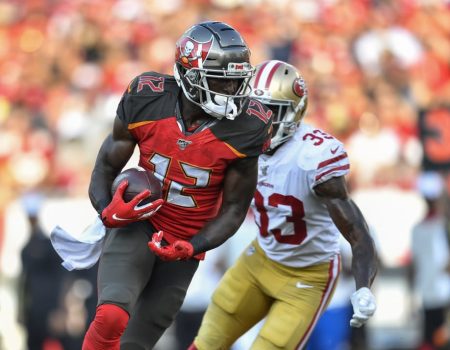This article first appeared on RotoBaller.com
By Cliff Clinton (@Cliff Clinton)
Depending on when you learned, or were taught, to play fantasy football, you picked up on a certain trend, whether consciously or subconsciously. While the fantasy community loves to talk about “Zero RB”, it’s a strategy that only got its name a few years ago.
Many of us that get tweeted or asked fantasy football questions each week have a hard time remembering, when push comes to shove, how Peyton Manning performed as a week-to-week fantasy starter when he was playing in Indianapolis, let alone guys like Jim Harbaugh.
Because when we talk about the game being “different back then,” we actually don’t have to look back that far to see how positions radically changed over five year increments.
It’s All About the Tiers
So, let’s take QB, specifically Jim Harbaugh. If you’re familiar with the San Francisco 49ers coach, you’re probably less familiar with the Indianapolis Colts starter. And twenty years ago, that starter was a fantasy liability. the 25th-ranked quarterback in terms of points per game (with at least five starts) at a whopping 10 points per game. This also made Jim the 94th player overall by the same metric, which sounds generous to some degree, but the 25th-ranked quarterback in 2016 (Ryan Tannehill) was good for the 54th-ranked overall player in points per game, all in relation to PPR scoring.
Why does all of this matter? Because it explains the growing trend of “You Can Wait on a Quarterback.” Year after year, it’s become something more prevalent because quarterbacks, no matter who they are, are still largely the highest scoring position by per game score. Jameis Winston, who probably didn’t win many leagues for people with his 15 points per game good for 20th-best at his position, also scored more points per game than Larry Fitzgerald, the guy who led the NFL in receptions! In a PPR league!
Ok, now that I’ve gotten past my feigned shock to prove a point, when quarterbacks as a whole tend to have this built in cushioning for scores, it means less and less reliance on picking a QB early on. If just about anyone can be better than the receiver with the most receptions, than who cares who you pick?
Here’s where the system gets the most interesting. The biggest gap for nearly every position sits at the top. The absolute best guy? He’s markedly better than the 10th guy. David Johnson this year was four points a game better than Ezekiel Elliott, which made the only guy in front of him in PPR scoring, Le’Veon Bell, five points better than the third best player at his position. Of course, that put Johnson and Bell at least ten points ahead of the 10th-best guy, Mark Ingram. But once you get past the top 10, the gap shrinks big time. Players 11 through 20 at WR, in PPR scoring, were separated by no more than two and a half total points in 2016 and 2015. For RB, this looked similar.
After (generally) the top 10 project wide receivers and the top 10 projected running backs are all off the board, then and only then based off of ADP are you left with the decision that brought you to this article. Do you draft a quarterback, or another running back or wide receiver?
We’ll qualify an “elite” quarterback in this case as a guy who will get you twenty points a game. And dependent on the last three years, you’re looking at a range of only four guys who have done it at least twice: Aaron Rodgers, Tom Brady, Drew Brees, Russell Wilson, and Andrew Luck. Three of the five of those guys were on at least 40% of teams that went to the playoffs (sorry, Luck and Wilson owners) in 2016.
You cannot tell, straight away, who is going to be a top-10 wide receiver or running back each year. There are guys who have proven to be repeated linchpins in great fantasy rosters for a few years, but it’s worth remembering that the average career of a quarterback in the NFL is three years. The average career of all positions is slightly more than two and a half years, each statistic a little bleak for the purposes of fantasy football. But it applies. Over that three year period, nine different wide receivers have claimed the title of “top five player in points per game.” 12 different running backs hold that title over the same period. For QBs, it was just five guys, all averaging at least 20 points a game each season.
It’s a long, long way to go to make a fantasy point. If you have an obvious top-five RB, you have to take him. If you have a young WR you believe could be a top-10 guy, take him too. It’s after these choices that you’ll be left with the possibility of picking from some of the best, most consistent arms in the game, or another offensive player who, statistically speaking, is probably worth one to two points of difference from a guy you’ll pick in the next round anyway. Yes, you could hit the lottery with a one-two running back punch who ends up topping the league and running you straight to the championship. And even if you pick another receiver to go along with that combo, there is basically no reason why you couldn’t also grab a consistent beacon of offensive production, and shore up a greater chance at reaching the playoffs.
Powered by WPeMatico






No Comment! Be the first one.